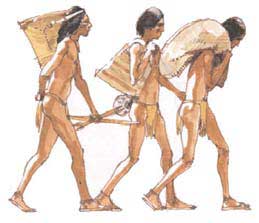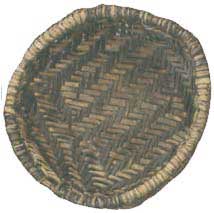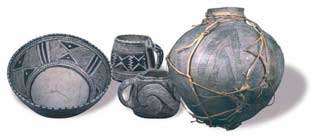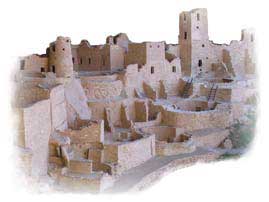| Mesa Verde |
Cliff Dwellers |
Family Life |
Tools |
Trade-Basketry-Pottery |
Geology |
All Photos |
|
Trade

|
Mesa Verde’s economy was more complex than you might suppose.
Even in a small farming community, some individuals undoubtedly
had more skill than others at weaving, leatherworking
or making pottery, arrowpoints, jewelry, baskets, sandals, or
other specialized articles. Their efficiency gave them a surplus,
which they shared or traded with neighbors. This exchange
went on between communities, too.
Seashells from the Pacific coast and turquoise, pottery, and cotton from the south made their way to Mesa Verde. They were passed along from village to village or carried by traders on foot over far-flung networks of trails. |
|
Basketry

|
The finest baskets made at Mesa Verde were created before the people learned how to make pottery. Using the spiral twilled technique, they wove handsomely decorated baskets of many sizes and shapes and used them for carrying water, storing grain, and even for cooking. They waterproofed baskets by lining them with pitch and cooked in them by dropping heated stones into the water. The most common coiling material was split willow, but sometimes rabbitbrush or skunkbush was used. After the introduction of pottery about A.D. 550, basketry declined. The few baskets found here from the Classic Period (A.D. 1100 to A.D. 1300), are not as well made as the earlier baskets. |
|
Pottery

|
The people of Mesa Verde were very accomplished potters, making vessels of many kinds: pots, bowls, canteens, ladles, jars, and mugs. Corrugated ware was used mostly for cooking and storage. The elaborately decorated black-on-white pottery may have had both ceremonial and everyday uses. Women were probably the potters. Designs tended to be personal and local and most likely were passed down from mother to daughter. Design elements changed slowly, a characteristic that helps archeologists and modern descendants track the location and composition of early populations. |
|
Buildings

|
Most of the cliff dwellings were built from the late A.D. 1190s to late A.D. 1270s. They range in size from one-room structures to villages of more than 150 rooms such as Cliff Palace and Long House. Architecturally, there is no standard ground plan. Builders fit the structures to the available space. Most walls were single courses of stone, perhaps because alcove roofs limited heights and protected the walls from erosion by the weather. Masonry work varied in quality -- rough construction is found alongside walls of well-shaped stones. Many rooms were plastered on the inside and decorated with painted designs. |
Copyright © 2003-2006 Calvin & Rosanna Hamilton. All rights reserved.